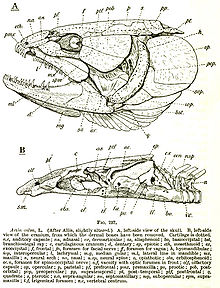
The hyomandibula, commonly referred to as hyomandibular (Latin: os hyomandibulare, from Greek: hyoeides, "upsilon-shaped" (υ), and Latin: mandibula, "jawbone"), is a set of bones that is found in the hyoid region in most fishes. It usually plays a role in suspending the jaws and/or operculum (teleostomi only). It is commonly suggested that in tetrapods (land animals), the hyomandibula evolved into the columella (stapes).
Evolutionary context
In jawless fishes, a series of gills opened behind the mouth, and these gills became supported by cartilaginous elements. The first set of these elements surrounded the mouth to form the jaw. There is ample evidence that vertebrate jaws are homologous to the gill arches of jawless fishes. The upper portion of the second embryonic arch supporting the gill became the hyomandibular bone of jawed fishes, which supports the skull and therefore links the jaw to the cranium.
When vertebrates found their way onto land, the hyomandibula, with its location near the ear, began to function as a sound amplifier beside its function to support the skull. As evolution later attached the cranium of terrestrial vertebrates to the rest of the skull, the hyomandibula lost its supportive function and became an interior organ, the stapes, and thus its secondary function had become its primary function.
See also
Notes
- J. A. Clack, "Earliest known tetrapod braincase and the evolution of the stapes and fenestra ovalis", Nature 369, 392–394 (2 June 1994);
- R. Eric Lombard, et al., "Evolution of the tetrapod ear: an analysis and reinterpretation", Biological Journal of the Linnean Society, Vol. 11, No. 1, pp. 19–76, 1979
- For example: (1) both sets of bones are made from neural crest cells (rather than mesodermal tissue like most other bones); (2) both structures form the upper and lower bars that bend forward and are hinged in the middle; and (3) the musculature of the jaw seem homologous to the gill arches of jawless fishes. (Gilbert 2000)
- ^ Gilbert 2000, Embryonic homologies
References
- Kardong, Kenneth V. Vertebrates Comparative Anatomy, Function, Evolution. pp. 227, 693.
- "Hyomandibula". ZipcodeZoo.com. Archived from the original on 14 March 2012. Retrieved 30 January 2010.
- Gilbert, Scott F. (2000). "The anatomical tradition: Evolutionary Embryology: Embryonic homologies". Developmental Biology. Sunderland (MA): Sinauer Associates, Inc. (NCBI). Retrieved 9 April 2018. (3rd and 4th paras, One of the most celebrated cases...)
- Gilbert (2000). "Comparative Embryology". Figure 1.14. Jaw structure in the fish, reptile, and mammal. (illustration). Sinauer Associates.
| Fish | |||||
|---|---|---|---|---|---|
| About fish |  | ||||
| Anatomy and physiology | |||||
| Sensory systems | |||||
| Reproduction | |||||
| Locomotion | |||||
| Other behaviour | |||||
| By habitat | |||||
| Other types | |||||
| Commerce |
| ||||
| Major groups | |||||
| Lists | |||||